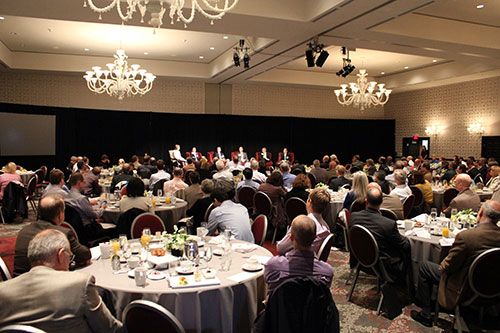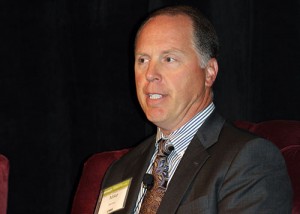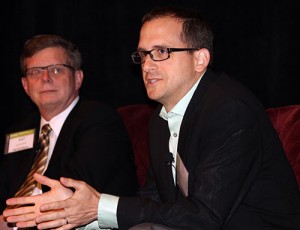“Medical offices are at the front line of healthcare delivery, with the emphasis on primary care and medical homes. Going forward there will be much more care and prevention done in medical offices than in past.”
~ Karl Sonnenberg, architect, Zimmer Gunsul Frasca Architects LLP
On May 22nd, a panel of five healthcare experts and 200 AEC industry leaders came together in Portland for an engaging discussion on the future of the Medical Office Building (MOB). The event, sponsored by Glumac, was StraightTalk’s MOB of the Future, was formulated to point the way for an industry facing major changes. Panelists offered a range of perspectives, including insights from a physician, architect, developer, contractor and engineer.

Open enrollment under the Affordable Care Act will begin in October 2013, giving an estimated 30-35 million currently uninsured users access to healthcare (1). Over the next decade, 78 million baby boomers approach retirement and will increasingly have additional medical needs (2). Demand for health services will grow significantly, and the type of care required will vary from today’s mix. Meanwhile, the cost to construct and operate hospitals continues to climb and provider budgets are tighter than ever. With these huge shifts in demographics and economics, healthcare needs to be more efficient, affordable, and accessible. The panel’s discussion uncovered three themes to watch for in MOB design and construction: accessibility, affordability, and sustainability.
Accessibility

As patient volumes swell, hospitals will struggle to make care accessible to more people. In response, there will be more integration of services in the community. Non-urgent services, such as out-patient surgeries, consultations, and therapies, will move out of the hospital and move closer to where patients live and work. This decentralization of infrastructure, distributed and closer to consumers, will harness less expensive facilities, built at a far lower cost than new hospital space.
To provide the right care at the right time, doctors will use a multi-disciplinary team approach. Architects need to design open floor plans to create “collaborative pod” settings that facilitate cross-discipline communication. Panelist Karl Sonnenberg, Architect, ZGF Architects, explained that such flexibility could be achieved by minimizing “monuments” in the middle of the building such as mechanical shafts, columns, stairs and elevators. The result creates open flexible space that allows for collaborative space where caregivers can communicate freely and work in teams.

Panelist Dr. Ruth Chang, Physician Service Area Director and Family Medicine Physician, Kaiser Permanente, highlighted the importance of integrating technology with patient services to improve access to healthcare. With digital record systems, physicians will be better able to access a patient’s comprehensive medical history and can balance face-to-face care with remote service capabilities to better accommodate patient lifestyles. To empower patients and promote lifelong health, there will be more ancillary services centered on preventative care and proactive wellness, such as fitness and dietary centers.
Technology will also add flexibility and accessibility for the patient. Remote care, delivered through innovative technologies (i.e. internal diagnostic devices, apps, and web-based consultations), will enable patients to receive care without having to physically visit a provider. The concept will also help to reduce the cost of care and allow patients the flexibility to receive care in ways with which they are comfortable. Dr. Chang, however, felt this will never fully replace face-to-face care. She explained that doctors will still need to examine patients in person. Also, the human relationship element that can speed the healing process is often gained only through personal interaction.
Affordability

Panelist Mike Denney, Managing Director, Healthcare Services, CBRE Group, Inc., offered a planning perspective for the MOB. He explained that providers need to be thinking like a business, focusing on controlling costs any way they can. They can do this by consolidating, renovating, and/or clustering related services across their MOB portfolios. Providers are moving many services out of the hospital to leave resources for acute care and providing select services where providers can better manage cost/sq ft for operations and cost/sq ft delivered.
Panelist Chip Cogswell, National Healthcare Director, Turner Construction added that while construction today is largely stick-built, there are strategies to bring costs down further. To minimize costs and delivery time, contractors are streamlining the design and construction process through the design-build delivery method, working with prefabricated modular building design, and using lean methods during construction.

In addition, he sees providers packaging MOB plans to accomplish these goals; Cogswell recalled one instance where the “architect was paid once for three hospitals.” Speaking to lean construction, he also described time and motion studies that tracked how many operations per hour a construction worker could perform using different techniques. The results of such process studies help cut away inefficiencies, reduce costs and speed up completion of MOB construction.
Sustainability
Because of the focus on human health and fiscal responsibility, there is a strong case to be made for sustainability in MOB design and planning. Sustainable engineering solutions, such as energy modeling, advanced controls, and daylighting, enable facilities to operate cost-effectively and provide optimal patient comfort.

Panelist David Summers, a Principal with Glumac, explained the importance of addressing building envelope performance first, to reduce building energy demand, complexity and cost of mechanical and lighting systems, and improve the financial feasibility of onsite, renewable energy generation. He explained, “The challenge is to find ways to improve energy and water efficiency without increasing first cost. For example, we designed for Kaiser in Southern California where we were able to deliver a Net Zero and LEED Platinum building at a cost premium of only 10-15%.” By designing for efficiency up front, informed by energy modeling, energy loads can be minimized. Other creative methods for reducing first cost include selecting systems appropriate for the regional climate, targeted use of LED lighting, and Power Purchase Agreements through third-party-owned renewable energy systems.
Doing More with Less
The MOB faces changes and challenges with competing demographic, political and economic factors. The MOB will have more users with varied needs, tighter design and construction budgets and timelines, and a greater need for comfortable, functional spaces that support health and wellness. These factors reinforce the need for accessible, affordable and sustainable MOB design and construction.
To achieve this, strategies include reducing operational costs through energy efficiency, simplifying design and construction through modular and lean solutions and creating environments that facilitate patient-centered care. In sum, designers and contractors of MOBs must collaborate to create better buildings that do more with less, “complement our environment and enhance our communities (3).”
(1) “What’s Changing and When: Open Enrollment in the Health Insurance Marketplace Begins.”HealthCare.Gov. Web. 01 June 2013. http://www.healthcare.gov/law/timeline
(2) “The Rising Health Care Needs of Aging Baby Boomers.” TopTenReviews. Web. 20 June 2013. http://medical-careers-review.toptenreviews.com/the-rising-health-care-needs-of-aging-baby-boomers.html
(3) “About USGBC.” US Green Building Council. Web. 19 June 2013. http://www.usgbc.org/about.
To learn more about MOB of the Future design and sustainable engineering solutions, email us at [email protected] or call 503.227.5280.
